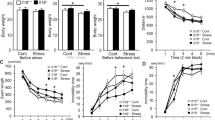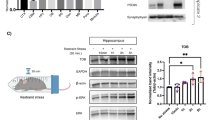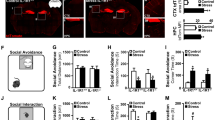Abstract
Interleukin-18 (IL18) is a multifunctional cytokine that has been implicated in increased susceptibility to depression; however, the underlying mechanism remains unknown. We found that the IL18 system in the basolateral amygdala (BLA) determined susceptibility to chronic stress. Mice subjected to chronic restraint stress or chronic foot-shock stress demonstrated increased expression of IL18 in the BLA, and exhibited depression-like behaviors, whereas IL18 knockout (KO) mice were resilient to these chronic stresses. IL18 and IL18 receptors in the BLA were expressed in glutamatergic and GABAergic neurons in addition to glial cells. Local inhibition of IL18 and IL18 receptors in the BLA by stereotaxic injection of siRNA-IL18 or siRNA-IL18 receptor-1α was sufficient to suppress stress-induced depression-like behaviors. Following chronic stress, the downstream mediator of IL18 receptor activation, phospho-NF-kB, was increased in BLA neurons expressing IL18 receptors. Furthermore, siRNA-mediated inhibition of NF-kB in the BLA significantly suppressed stress-induced depression-like behaviors, and NF-kB KO mice were resilient to chronic stress. The siRNA-mediated inhibition of NF-kB in the BLA downregulated stress-induced increased expression of Hcrt, MCH, OXT, AVP, and TRH, the neuropeptides that were induced by chronic stress in the BLA and promoted depression-like behaviors. These results suggest that the local IL18 and its receptor system in the BLA function as molecular regulators promoting susceptibility to chronic stress.





Similar content being viewed by others
Change history
07 October 2016
An erratum to this article has been published.
References
Schiepers OJ, Wichers MC, Maes M (2005) Cytokines and major depression. Prog Neuro-Psychopharmacol Biol Psychiatry 29:201–217
Raison CL, Capuron L, Miller AH (2006) Cytokines sing the blues: inflammation and the pathogenesis of depression. Trends Immunol 27:24–31
Felger JC, Lotrich FE (2013) Inflammatory cytokines in depression: neurobiological mechanisms and therapeutic implications. Neuroscience 246:199–229
Cattaneo A, Macchi F, Plazzotta G, Veronica B, Bocchio-Chiavetto L, Riva MA, et al. (2015) Inflammation and neuronal plasticity: a link between childhood trauma and depression pathogenesis. Front Cell Neurosci 9:40
Merendino RA, Di Rosa AE, Di Pasquale G, Minciullo PL, Mangraviti C, Costantino A, et al. (2002) Interleukin-18 and CD30 serum levels in patients with moderate-severe depression. Mediat Inflamm 11:265–267
Alcocer-Gomez E, de Miguel M, Casas-Barquero N, Nunez-Vasco J, Sanchez-Alcazar JA, Fernandez-Rodriguez A, et al. (2014) NLRP3 inflammasome is activated in mononuclear blood cells from patients with major depressive disorder. Brain Behav Immun 36:111–117
Dantzer R, O'Connor JC, Freund GG, Johnson RW, Kelley KW (2008) From inflammation to sickness and depression: when the immune system subjugates the brain. Nat Rev Neurosci 9:46–56
Hodes GE, Pfau ML, Leboeuf M, Golden SA, Christoffel DJ, Bregman D, et al. (2014) Individual differences in the peripheral immune system promote resilience versus susceptibility to social stress. Proc Natl Acad Sci U S A 111:16136–16141
Barksby HE, Lea SR, Preshaw PM, Taylor JJ (2007) The expanding family of interleukin-1 cytokines and their role in destructive inflammatory disorders. Clin Exp Immunol 149:217–225
Gracie JA, Robertson SE, McInnes IB (2003) Interleukin-18. J Leukoc Biol 73:213–224
Alboni S, Cervia D, Sugama S, Conti B (2010) Interleukin 18 in the CNS. J Neuroinflammation 7:9
Dinarello CA, Novick D, Kim S, Kaplanski G (2013) Interleukin-18 and IL-18 binding protein. Front Immunol 4:289
Culhane AC, Hall MD, Rothwell NJ, Luheshi GN (1998) Cloning of rat brain interleukin-18 cDNA. Mol Psychiatry 3:362–366
Hedtjarn M, Leverin AL, Eriksson K, Blomgren K, Mallard C, Hagberg H (2002) Interleukin-18 involvement in hypoxic-ischemic brain injury. J Nerurosci 22:5910–5919
Sugama S, Fujita M, Hashimoto M, Conti B (2007) Stress induced morphological microglial activation in the rodent brain: involvement of interleukin-18. Neuroscience 146:1388–1399
Jeon GS, Park SK, Park SW, Kim DW, Chung CK, Cho SS (2008) Glial expression of interleukin-18 and its receptor after excitotoxic damage in the mouse hippocampus. Neurochem Res 33:179–184
Alboni S, Cervia D, Ross B, Montanari C, Gonzalez AS, Sanchez-Alavez M, et al. (2009) Mapping of the full length and the truncated interleukin-18 receptor alpha in the mouse brain. J Neuroimmunol 214:43–54
Ojala J, Alafuzoff I, Herukka SK, van Groen T, Tanila H, Pirttila T (2009) Expression of interleukin-18 is increased in the brains of Alzheimer’s disease patients. Neurobiol Aging 30:198–209
Chen ML, Cao H, Chu YX, Cheng LZ, Liang LL, Zhang YQ, et al. (2012) Role of P2X7 receptor-mediated IL-18/IL-18R signaling in morphine tolerance: multiple glial-neuronal dialogues in the rat spinal cord. J Pain 13:945–958
Kokai M, Kashiwamura S, Okamura H, Ohara K, Morita Y (2002) Plasma interleukin-18 levels in patients with psychiatric disorders. J Immunother 25(Suppl 1):S68–S71
Haastrup E, Bukh JD, Bock C, Vinberg M, Thorner LW, Hansen T, et al. (2012) Promoter variants in IL18 are associated with onset of depression in patients previously exposed to stressful-life events. J Affect Disord 136:134–138
Giedraitis V, He B, Huang WX, Hillert J (2001) Cloning and mutation analysis of the human IL-18 promoter: a possible role of polymorphisms in expression regulation. J Neuroimmunol 112:146–152
Seino D, Tokunaga A, Tachibana T, Yoshiya S, Dai Y, Obata K, et al. (2006) The role of ERK signaling and the P2X receptor on mechanical pain evoked by movement of inflamed knee joint. Pain 123:193–203
Sugama S, Wang N, Shimokawa N, Koibuchi N, Fujita M, Hashimoto M, et al. (2006) The adrenal gland is a source of stress-induced circulating IL-18. J Neuroimmunol 172:59–65
Kroes RA, Panksepp J, Burgdorf J, Otto NJ, Moskal JR (2006) Modeling depression: social dominance-submission gene expression patterns in rat neocortex. Neuroscience 137:37–49
Seo JS, Park JY, Choi J, Kim TK, Shin JH, Lee JK, et al. (2012) NADPH oxidase mediates depressive behavior induced by chronic stress in mice. J Neurosci 32:9690–9699
Kim TK, Kim JE, Park JY, Lee JE, Choi J, Kim H, et al. (2015a) Antidepressant effects of exercise are produced via suppression of hypocretin/orexin and melanin-concentrating hormone in the basolateral amygdala. Neurobiol Dis 79:59–69
Kim TK, Lee JE, Kim JE, Park JY, Choi J, Kim H, et al. (2015b) G9a-mediated regulation of OXT and AVP expression in the basolateral amygdala mediates stress-induced lasting behavioral depression and its reversal by exercise. Mol Neurobiol 53:2843–2856
Choi J, Kim JE, Kim TK, Park JY, Lee JE, Kim H, et al. (2015) TRH and TRH receptor system in the basolateral amygdala mediate stress-induced depression-like behaviors. Neuropharmacology 97:346–356
Yamamoto Y, Tanahashi T, Katsuura S, Kurokawa K, Nishida K, Kuwano Y, et al. (2010) Interleukin-18 deficiency reduces neuropeptide gene expressions in the mouse amygdala related with behavioral change. J Neuroimmunol 229:129–139
Takeda K, Tsutsui H, Yoshimoto T, Adachi O, Yoshida N, Kishimoto T, et al. (1998) Defective NK cell activity and Th1 response in IL-18-deficient mice. Immunity 8:383–390
Sha WC, Liou HC, Tuomanen EI, Baltimore D (1995) Targeted disruption of the p50 subunit of NF-kappa B leads to multifocal defects in immune responses. Cell 80:321–330
Park JY, Kim TK, Choi J, Lee JE, Kim H, Lee EH, et al. (2014) Implementation of a two-dimensional behavior matrix to distinguish individuals with differential depression dtates in a rodent model of depression. Exp Neurobiol 23:215–223
Liu X, Ramirez S, Pang PT, Puryear CB, Govindarajan A, Deisseroth K, et al. (2012) Optogenetic stimulation of a hippocampal engram activates fear memory recall. Nature 484:381–385
Jeon D, Kim S, Chetana M, Jo D, Ruley HE, Lin SY, et al. (2010) Observational fear learning involves affective pain system and Cav1.2 Ca2+ channels in ACC. Nat Neurosci 13:482–488
Baek IS, Park JY, Han PL (2015) Chronic antidepressant treatment in normal mice induces anxiety and impairs stress-coping ability. Exp Neurobiol 24:156–168
Gilmore TD (2006) Introduction to NF-kappaB: players, pathways, perspectives. Oncogene 25:6680–6684
Khemka VK, Ganguly A, Bagchi D, Ghosh A, Bir A, Biswas A, et al. (2014) Raised serum proinflammatory cytokines in Alzheimer’s disease with depression. Aging Dis 5:170–176
McDonald AJ (1992) Projection neurons of the basolateral amygdala: a correlative Golgi and retrograde tract tracing study. Brain Res Bull 28:179–185
Fritsch B, Qashu F, Figueiredo TH, Aroniadou-Anderjaska V, Rogawski MA, Braga MF (2009) Pathological alterations in GABAergic interneurons and reduced tonic inhibition in the basolateral amygdala during epileptogenesis. Neuroscience 163:415–429
Woodruff AR, Monyer H, Sah P (2006) GABAergic excitation in the basolateral amygdala. J Neurosci 26:11881–11887
Aroniadou-Anderjaska V, Qashu F, Braga MF (2007) Mechanisms regulating GABAergic inhibitory transmission in the basolateral amygdala: implications for epilepsy and anxiety disorders. Amino Acids 32:305–315
Masneuf S, Lowery-Gionta E, Colacicco G, Pleil KE, Li C, Crowley N, Flynn S, et al. (2014) Glutamatergic mechanisms associated with stress-induced amygdala excitability and anxiety-related behavior. Neuropharmacology 85:190–197
Acknowledgments
This research was supported by grants (2015R1A2A2A01003413; WCI 2009-002) from the Ministry of Science, ICT and Future Planning, Republic of Korea, and KRIBB Research Initiative Program.
Author information
Authors and Affiliations
Corresponding authors
Ethics declarations
Competing Interests Statement
The authors declare no competing financial interests.
Additional information
An erratum to this article is available at https://doi.org/10.1007/s12035-016-0139-1.
Electronic Supplementary Material
Supplemental Fig. S1
Shock sensitivity and shock-escaping tests of IL18 KO mice. a Experimental design for the shock sensitivity test and subsequent shock-escaping test. b Behavioral responses in the shock sensitivity test. Mice grouped to be subjected to the foot-shock regime were individually exposed to a single 0.8-mA electrical shock 2 s in duration through a shock grid floor in a shock chamber. Shock responders were defined as mice showing jumping, high-pitched vocalization, and/or saccadic movement in response to an electrical shock. Non-responders were defined as mice showing none of these behavioral responses to the single shock trial. c, d Behavioral responses in the shock-escaping test. Mice were subjected to a single 0.8-mA electrical shock 2 s in duration through a shock grid floor in the shock chamber containing an escaping block in a corner (c). In response to shock, mice normally jumped onto the escaping block. The mice who failed to escape were given a second electrical shock 10 s after the first trial, and escaping responses were recorded. Animals that escaped on the first and second trials were counted as percentage of successful shock escapes (d). All IL18 KO mice tested were successfully escaped on the first or second trial. (GIF 138 kb)
Supplemental Figure S2
GFAP-positive cells in the BLA were rare. a, b Photomicrographs showing anti-GFAP staining in the hippocampus (a) and BLA (b). Numerous anti-GFAP-stained cells were present in the hippocampus, while anti-GFAP-stained cells were relatively rare in the BLA. However, the surrounding areas of the BLA contained a number of anti-GFAP-stained cells. CA1 hippocampal CA1, DG dentate gyrus, BLA basolateral amygdala. (GIF 270 kb)
Supplemental Fig. S3
Expression of IL18 and IL18 receptors in the BLA. a Photomicrograph showing the location (white rectangle) for high magnification images in panels (b)–(i) and the area in the BLA used for quantifications (blue circle). CeA central amygdala, BLA basolateral amygdala. Scale bar = 200 μm. b–i Expressions of proIL18 (b–e) and IL18Rα (f–i) in the BLA. Photomicrographs representing the co-localization of proIL18 and GAD67 (b), proIL18 and Glu-4 (c), IL18Rα and GAD67 (f), and IL18Rα and Glu-4 (g) in the BLA of mice treated with 2 h × 14 d RST. Venn diagrams for the quantification of co-localization of proIL18 and GAD67 (d), proIL18 and Glu-4 (e), IL18Rα and GAD67 (h), IL18Rα and Glu-4 (i), and the number of counted cells of each marker. The specificity of proIL18 and IL18Rα antibodies was verified using BLA sections of IL18 KO mice and BLA sections injected with siRNA-IL18Rα, respectively. Scale bars = 100 μm. (GIF 610 kb)
Supplemental Fig. S4
IL18Rα was expressed in BLA cells positive for proHcrt, proMCH, proOXT, proAVP, or proTRH. a Photomicrograph showing the location (red rectangle) in the BLA for high magnifications of panels (b)–(f). CeA central amygdala, BLA basolateral amygdala. Scale bar = 200 μm. b–f Photomicrographs representing the co-localization of IL18Rα and proHcrt (b), IL18Rα and proMCH (c), IL18Rα and proOXT (d), IL18Rα and proAVP (e), and IL18Rα and proTRH (f) in BLA neurons. Scale bar = 20 μm. (GIF 489 kb)
Supplemental Fig. S5
Stress-induced c-Fos expression in glutamatergic and GABAergic neurons in the BLA. a Experimental design for the treatment of mice with daily 2-h restraint for 7 days (gray squares), following 1-h restraint (gray rectangle) on day 8, and tissue preparation (arrow). b–d Photomicrographs showing the co-staining of c-Fos (green) and GAD67 (red) (b), c-Fos (green) and PAV (red) (c), and c-Fos (green) and Glu-4 (red) (d) in the BLA of mice exposed to restraint stress. Arrowheads—co-stained cells. Scale bar = 100 μm. e–g Venn diagrams for the quantification of co-localization of c-Fos and GAD67 (e), c-Fos and PAV (f), and c-Fos and Glu-4 (g), and the number of counted cells of each marker. (GIF 487 kb)
Supplemental Fig. S6
Stress-induced c-Fos expression in IL18- or IL18 receptor-expressing cells in the BLA. a Experimental design for the treatment of mice with daily 2-h restraint for 7 days (gray squares), following 1-h restraint (gray rectangle) on day 8, and tissue preparation (arrow). b, c Photomicrographs showing the co-staining of proIL18 (green) and c-Fos (red) (a), and IL18Rα (green) and c-Fos (red) (b) in the BLA of mice exposed to restraint stress. Arrowheads—co-stained cells. Scale bar = 100 μm. (GIF 220 kb)
Supplemental Fig. S7
Phospho-NF-kB p65 and phospho-STAT3 were detected in GABAergic and glutamatergic cells in the BLA. a Photomicrograph showing the location (white rectangle) for high magnifications in panels (b)–(g). CeA central amygdala, BLA basolateral amygdala. Scale bar = 200 μm. b, c Photomicrographs showing the co-localization of phospho-NF-kB p65 (p-NF-kB; green) and NeuN (red) (b) and phospho-STAT3 (p-STAT3; green) and NeuN (red) (c) in the BLA of mice treated with 2 h × 14 d RST. Scale bar = 20 μm. d, e Photomicrographs representing the co-localization of p-NF-kB p65 (p-NF-kB; green) and GAD67 (red) (d), and p-NF-kB p65 (p-NF-kB; green) and Glu-4 (red) (e) in the BLA of mice treated with 2 h × 14 d RST. Scale bar = 20 μm. f, g Photomicrographs showing the co-localization of p-STAT3 (green) and GAD67 (red) (f), and p-STAT3 (green) and Glu-4 (red) (g) in the BLA of mice treated with 2 h × 14 d RST. Scale bar = 20 μm. (GIF 549 kb)
Supplemental Fig. S8
Shock sensitivity and shock-escaping tests of NF-kB KO mice. a Experimental design for the shock sensitivity test and shock-escaping test. b Prescreening of mice based on the shock sensitivity test. Mice grouped to be subjected to the foot-shock regime were individually exposed to a single 0.8-mA electrical shock 2 s in duration through a shock grid floor in a shock chamber. Shock responders were defined as mice showing jumping, high-pitched vocalizations, and/or saccadic movements in response to an electrical shock, and non-responders as mice showing none of these behavioral responses. c, d Shock-escaping behaviors of WT and NF-kB KO mice. Mice were subjected to a single 0.8-mA electrical shock 2 s in duration through a shock grid floor in the shock chamber containing an escaping block in a corner (c). In response to shock, mice normally jumped onto the escaping block. The mice who failed to escape were given a second electrical shock 10 s after the first trial, and successful escapes were recorded. Animals that escaped on the first and second trials were counted as percentage of successful shock escapes (d). All NF-kB KO mice tested were successfully escaped on the first or second trial. (GIF 141 kb)
Supplemental Fig. S9
Potential NF-kB and STAT3 binding sites in the promoter regions of Hcrt, MCH, OXT, AVP, and TRH genes. Schematic representation of potential NF-kB and STAT3 binding sites on the promoter regions of Hcrt, MCH, OXT, AVP, and TRH genes. The 1000 base-pair proximal promoter region of Hcrt, MCH, OXT, and AVP genes contains a NF-kB binding site (red box), while the TRH promoter region contains a STAT3 binding site (blue box). Numbers represent the distance from the transcription start site (TSS) of each gene. (GIF 17 kb)
ESM 1
(DOCX 63 kb)
Rights and permissions
About this article
Cite this article
Kim, TK., Kim, JE., Choi, J. et al. Local Interleukin-18 System in the Basolateral Amygdala Regulates Susceptibility to Chronic Stress. Mol Neurobiol 54, 5347–5358 (2017). https://doi.org/10.1007/s12035-016-0052-7
Received:
Accepted:
Published:
Issue Date:
DOI: https://doi.org/10.1007/s12035-016-0052-7




